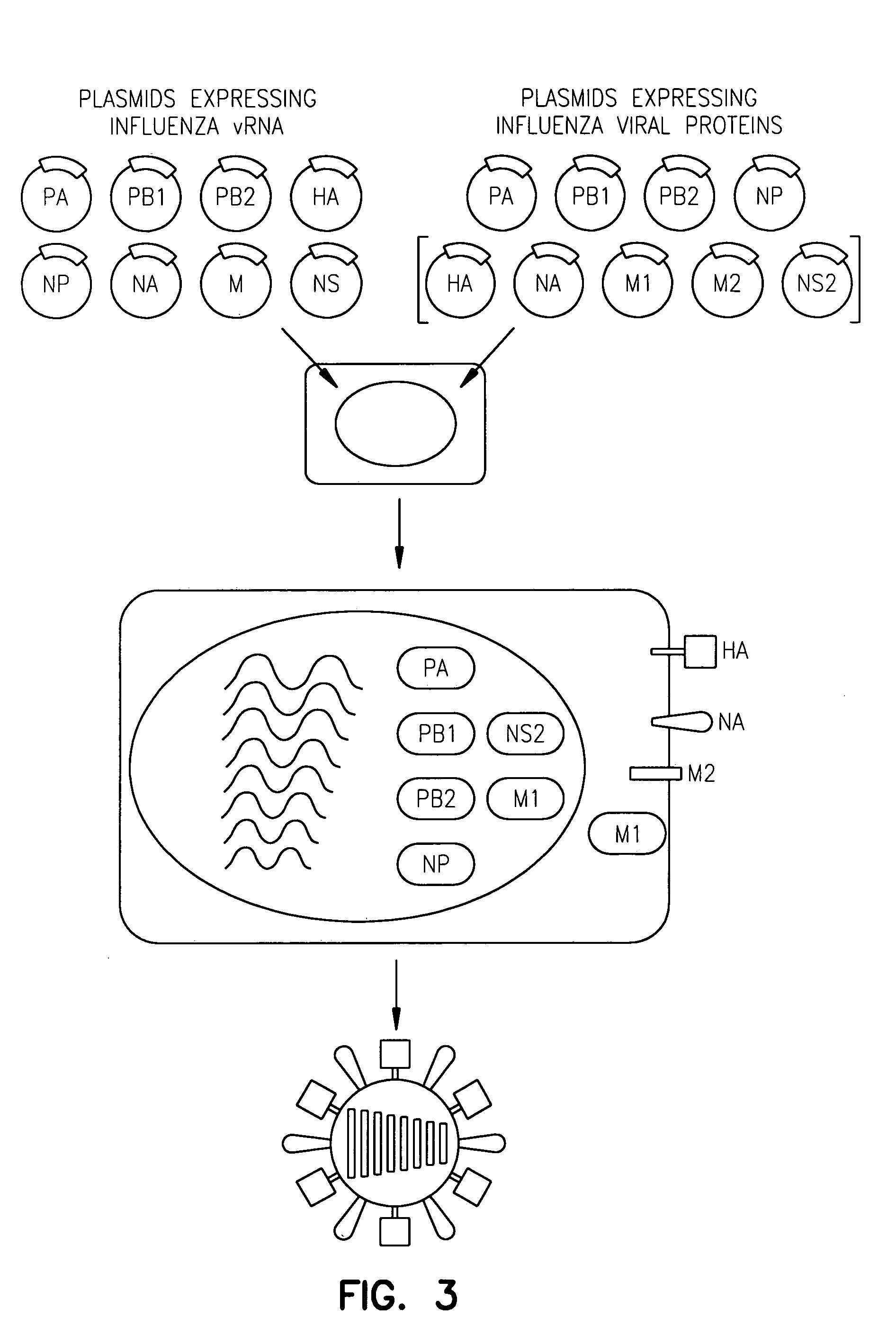Viruses comprising mutant ion channel protein
- Summary
- Abstract
- Description
- Claims
- Application Information
AI Technical Summary
Benefits of technology
Problems solved by technology
Method used
Image
Examples
example 1
Materials and Methods
[0037] Cells and viruses. 293T human embryonic kidney cells and Madin-Darby canine kidney cells (MDCK) were maintained in Dulbecco's modified Eagle medium (DMEM) supplemented with 10% fetal calf serum and in modified Eagle's medium (MEM) containing 5% newborn calf serum, respectively. All cells were maintained at 37° C. in 5% CO2. Influenza viruses A / WSN / 33 (H1N1) and A / PR / 8 / 34 (H1N1) were propagated in 10-day-old eggs.
[0038] Construction of plasmids. To generate RNA polymerase I constructs, cloned cDNAs derived from A / WSN / 33 or A / PR / 8 / 34 viral RNA were introduced between the promoter and terminator sequences of RNA polymerase I. Briefly, the cloned cDNAs were amplified by PCR with primers containing BsmBI sites, digested with BsmBI, and cloned into the BsmBI sites of the pHH21 vector which contains the human RNA polymerase I promoter and the mouse RNA polymerase I terminator, separated by BsmBI sites (FIG. 2). The PB2, PB1, PA, HA, NP, NA, M, and NS genes of...
example 2
Materials and Methods
[0053] Cells and viruses. 293T human embryonic kidney cells and Madin-Darby canine kidney cells (MDCK) were maintained in DMEM supplemented with 10% FCS and in MEM containing 5% newborn calf serum, respectively. The 293T cell line is a derivative of the 293 line, into which the gene for the simian virus 40 T antigen was inserted (DuBridge et al., 1987). All cells were maintained at 37° C. in 5% CO2. Influenza virus A / Udorn / 307 / 72 (H3N2) (Udorn) was propagated in 10-day-old eggs.
[0054] Construction of plasmids. The cDNA of Undorn virus was synthesized by reverse transcription of viral RNA with an oligonucleotide complementary to the conserved 3′ end of viral RNA, as described by Katz et al. (1990). The cDNA was amplified by PCR with M gene-specific oligonucleotide primers containing BsmBI sites, and PCR products were cloned into the pT7Blueblunt vector (Novagen, Madison, Wis.). The resulting construct was designated pTPo1UdM. After digestion with BsmBI, the fr...
example 3
Materials and Methods
[0078] Cells and viruses. 293T human embryonic kidney cells and Madin-Darby canine kidney (MDCK) cells were maintained in DMEM supplemented with 10% FCS and in MEM containing 5% newborn calf serum, respectively. The 293T cell line is a derivative of the 293 line, into which the gene for the simian virus 40 T antigen was inserted (Dubridge et al., 1987). All cells were maintained at 37° C. in 5% CO2. M2del29-31 and WSN-UdM (wild-type) viruses were propagated in MDCK cells. A / WSN / 33 (H1N1) virus was propagated in 10-day-old embryonated chicken eggs.
[0079] Immunization and protection tests. BALB / c mice (4-week-old female) were intranasally immunized with 50 μL of 1.1×105 PFU per ml of M2del29-31 or wild-type WSN-UdM viruses. On the second week, four mice were sacrificed to obtain sera, trachea-lung washes, and nasal washes. Two weeks and one or three months after the vaccination, immunized mice were challenged intranasally, under anesthesia, with 100 LD50 doses ...
PUM
| Property | Measurement | Unit |
|---|---|---|
| Volume | aaaaa | aaaaa |
| Volume | aaaaa | aaaaa |
| Volume | aaaaa | aaaaa |
Abstract
Description
Claims
Application Information
 Login to View More
Login to View More - R&D
- Intellectual Property
- Life Sciences
- Materials
- Tech Scout
- Unparalleled Data Quality
- Higher Quality Content
- 60% Fewer Hallucinations
Browse by: Latest US Patents, China's latest patents, Technical Efficacy Thesaurus, Application Domain, Technology Topic, Popular Technical Reports.
© 2025 PatSnap. All rights reserved.Legal|Privacy policy|Modern Slavery Act Transparency Statement|Sitemap|About US| Contact US: help@patsnap.com



